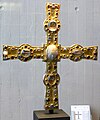Roman and Venetian Quattrocento (Klimt)

|
| Roman and Venetian Quattrocento |
|---|
| Gustav Klimt , 1891 |
| Oil on canvas |
| Kunsthistorisches Museum , Vienna |
The Roman and Venetian Quattrocento is a picture by Gustav Klimt in a pair of gussets and intercolumns on the north wall (left) in the stairwell of the Kunsthistorisches Museum in Vienna from 1891.
Emergence
Klimt also executed other gusset and intercolumned pictures in the stairwell, including Greek antiquity and Egypt , old Italian art and Florentine Cinquecento and Quattrocento .
description
Motif and presentation
The pictures are allegories of the Quattrocento in Rome and Venice . Klimt creates them like profile portraits of the early Italian Renaissance . With the exception of the heads, the posture is very similar in both figures; the artist implements a renaissance image concept based on symmetry . The three-quarter profile figures each stand in front of a tondo and an egg stick and turn their backs to one another, the architectural background is uniformly designed by Klimt. The artist mainly uses gold as a color in combination with ocher and brown tones .
The Roman Quattrocento is represented by a woman who appears as an Ekklesia and thus embodies the Roman papacy . The figure is shown from the side with the head slightly turned towards the viewer. It bears a halo and a cope decorated with elaborate embroidery depicting scenes , the lower part of which, with its red hem, extends into the intercolumnium on the left. A Renaissance baptismal font is depicted in this intercolumnium , with sculptures of tied men on the base. Ekklesia holds a tiara in front of her, a processional cross leans on her right shoulder . The inscription Pontifex can be read on the tondo in the background . The bluish center of the tondo and the red hem of the coat create a color contrast.
In the Venetian Quattrocento , Klimt shows a doge in pure side profile, whose head and gaze are directed slightly downwards. He wears a coat made of gold-colored brocade fabric with round buttons, the so-called campanoni d'oro . His head is covered by the zogia , underneath you can see a cuffia . Klimt dispenses with stronger contrasts in the Doge's color scheme. A lion of St. Mark, painted with a nimbus , can be seen behind the doge . In his paws he holds a golden book with the inscription: "PAX TIBI MARCE EVANGELISTA MEUS" ( Peace be upon you, Markus, my evangelist ).
interpretation
The look that the Ekklesia throws at the viewer on the one hand looks like girlish shyness, but on the other hand it can also be perceived as a threat due to the sideways head position. The spread of the vespers mantle into the adjoining intercolumn probably symbolizes the wide spread of the church. The men tied to the base of the baptismal font represent the souls bound and freed by the sacrament of baptism . The fact that the Ekklesia and Doge turn their backs on each other probably indicates the rivalry between Rome and Venice in the 15th century. The dominant color gold represents spiritual and worldly power.
Parallels to other works of art
The face of the Ekklesia bears a strong resemblance to one of the Two Girls with Oleander (1890), a painting by Klimt made in the same year as the designs for the gusset and intercolumnia pictures. The processional cross in the Roman Quattrocento resembles the Heinrichskreuz from the Basel Minster Treasure , the tiara in front of the Ekklesia of a Pius IX. Pope's crown donated in 1877. The Doge's features and clothes are the same as those of Leonardo Loredan in a portrait by Giovanni Bellini . The figure of the lion is reminiscent of the famous sculpture on the Piazzetta in Venice.
Heinrichskreuz , Basel Minster Treasure
G. Bellini: Portrait of Leonardo Loredan (1501, National Gallery , London).
literature
- Otmar Rychlik: Gustav Klimt, Franz Matsch and Ernst Klimt in the Kunsthistorisches Museum. Catalog for the special exhibition (Klimt Bridge). Edition Kunst on behalf of the Kunsthistorisches Museum, Vienna 2012.
- Beatrix Kriller, Georg Johannes Kugler: The Art History Museum, the architecture and furnishings . C. Brandstätter Publishing House, 1991.
Individual evidence
- ↑ Alice Strobl: Gustav Klimt - The Drawings 1878-1903 . Verlag Galerie Welz, Salzburg 1980. ISBN 978-3853490167 , p. 86.
Web links
- Gustav Klimt in the Kunsthistorisches Museum. KHM press articleon the special exhibition (Klimt Bridge) 2012. Accessed on December 23, 2013.
- KHM: Bridge brings visitors closer to Klimt. Article by the courier on the special exhibition 2012. With photos of the murals as a slideshow. Retrieved December 23, 2013.
- Vienna / KHM: Gustav Klimt in the Kunsthistorisches Museum. New Merker article on the 2012 special exhibition. Accessed December 23, 2013.
- The gusset and intercolumned pictures in the stairwell of the KHM. Article by Hedwig Abraham on the Viennatouristguide website, July 2002. Accessed December 23, 2013.






